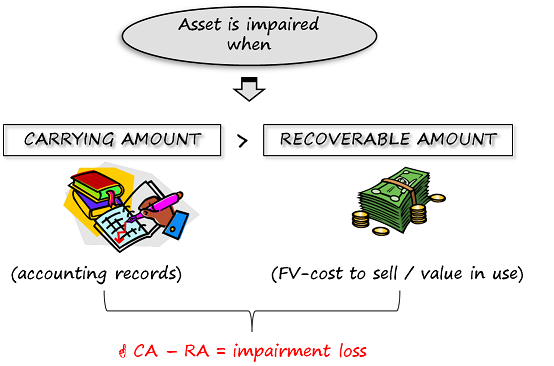What is an impairment of assets?
An asset is impaired when its carrying amount is greater than its recoverable amount.

The carrying amount of an asset is the amount shown in the accounting records. The recoverable amount of an asset is in fact the asset's "real value" (we'll come back to this).
So, when accounting records show the assets at higher amounts than their "real value", then there is an impairment of assets and we should recognize some impairment loss.
How do we find out that there is impairment?
Every company shall watch out for external and internal indicators of a possible impairment.
External indicators are: significant decline in market value, significant adverse changes in technological, market, economic or legal environment, increase in market interest rates or rates of return, and carrying amount of company's net assets exceeds market capitalization.
Internal indicators are: obsolescence or physical damage, internal evidence available that asset's performance will be worse than expected, significant adverse changes to company including plans to discontinue or restructure an operation using the asset or to dispose of it earlier than planned.
Therefore, if the company finds any of these indicators, it should determine asset's recoverable amount and find out whether there is impairment.
What is a recoverable amount?
According to IAS 36, a recoverable amount is the higher of an asset's fair value less cost to sell and asset's value in use.
Fair value less cost to sell is the amount which could be obtained from the sale of the asset after deducting expenses in order to sell it (for example, some preparation or cleaning of asset before sale). Basically, it is a price set in the sale agreement or market price of similar assets.
Value in use is the discounted or present value of future cash flows expected to arise from either continuing use of an asset and its disposal at the end of its useful life.
What is a cash generating unit (CGU)?
Sometimes it is not possible to determine the recoverable amount for some assets because they are a part of some group of assets and do not generate their own cash inflow.
For example, a pizza oven in a pizzeria – the pizza oven itself does not generate any cash flow, but is a part of a restaurant and helps to generate the restaurant's cash flow.
Therefore, IAS 36 introduces a concept of cash generating units (CGU), which is the smallest identifiable group of assets that generates cash inflow from continuing use that are largely independent of the cash inflows of other assets.
In our small pizza example, the cash generating unit would be the whole pizzeria and all assets would belong to this CGU.

How to calculate impairment loss?
Impairment loss is calculated as the asset's or CGU's carrying amount less the asset's or CGU's recoverable amount.
If it is not possible to calculate the recoverable amount of an individual asset, then calculate the recoverable amount of the whole CGU and determine impairment loss for the whole CGU.
The CGU's impairment loss then must be allocated to the individual assets.
So, if you calculated the impairment loss for the whole pizzeria, then you must allocate this loss to its individual assets, including the pizza oven :).
How to account for impairment loss?
If a cost model is applied, then the impairment loss is recognized as:
![]()
If a revaluation model is applied, then the impairment loss is recognized as:
![]()
Be careful, because if there was no revaluation surplus in the equity, then you should recognize impairment loss to profit or loss account.
And do not forget to adjust the depreciation for the future periods!
Is it possible to reverse impairment loss?
Yes – if there are some indicators that impairment loss might have decreased. Reversal of impairment loss under cost model is always recognized as:
![]()
Again, adjust the depreciation for the future periods. And never reverse impairment loss on goodwill – that is prohibited by IAS 36.
No comments:
Post a Comment